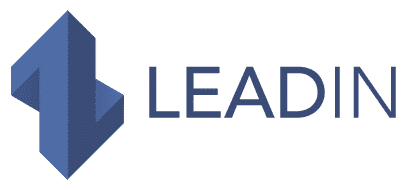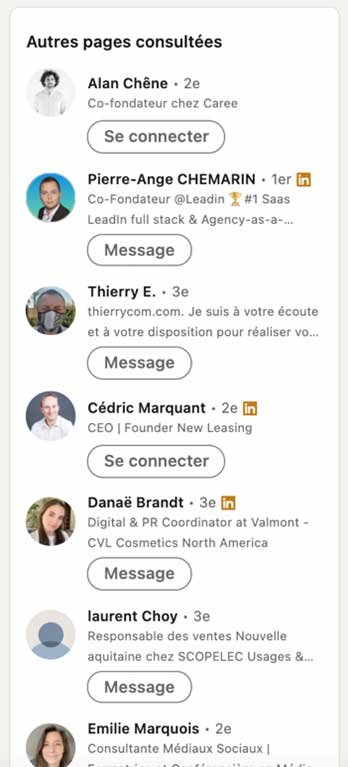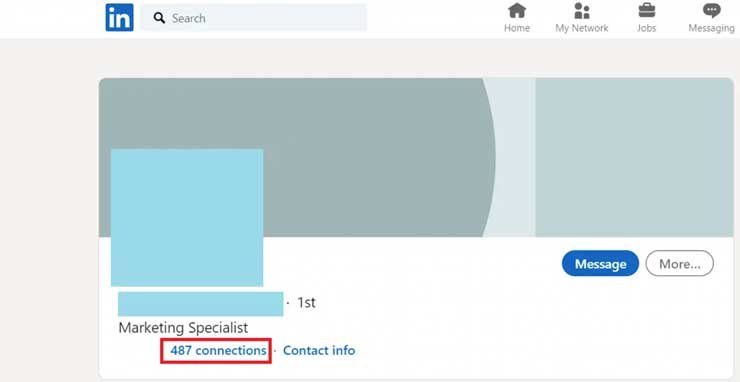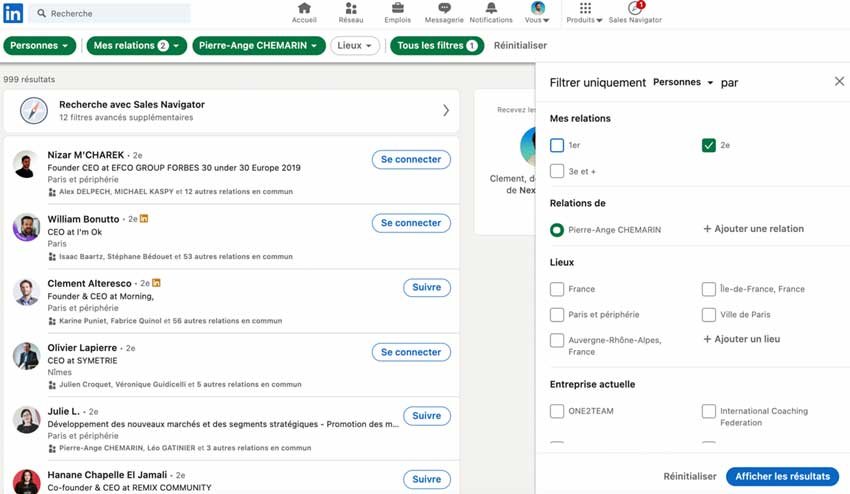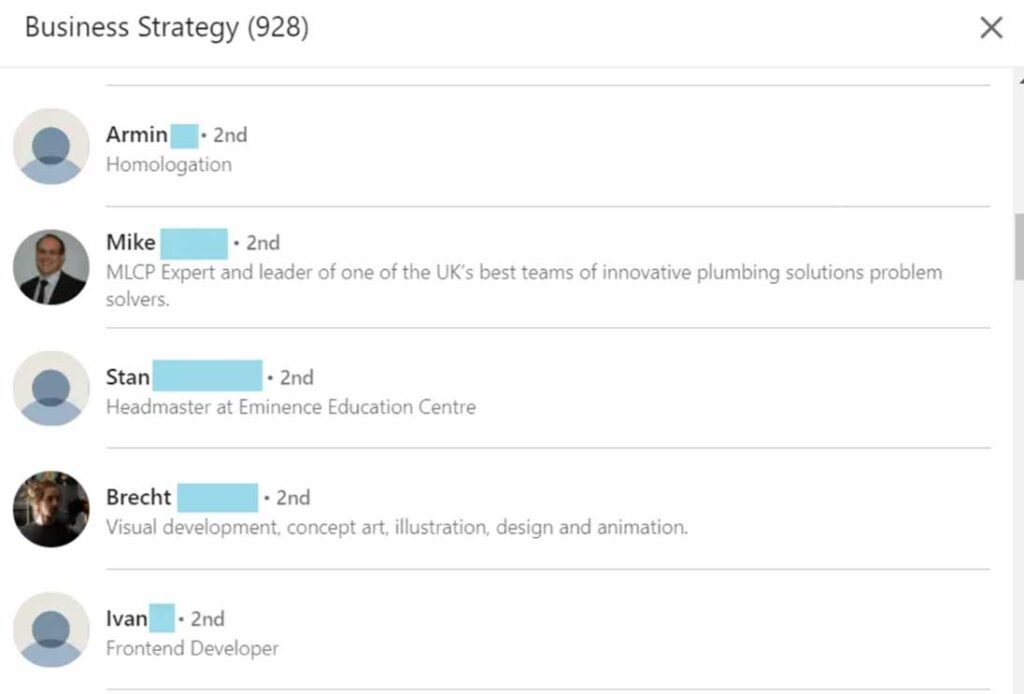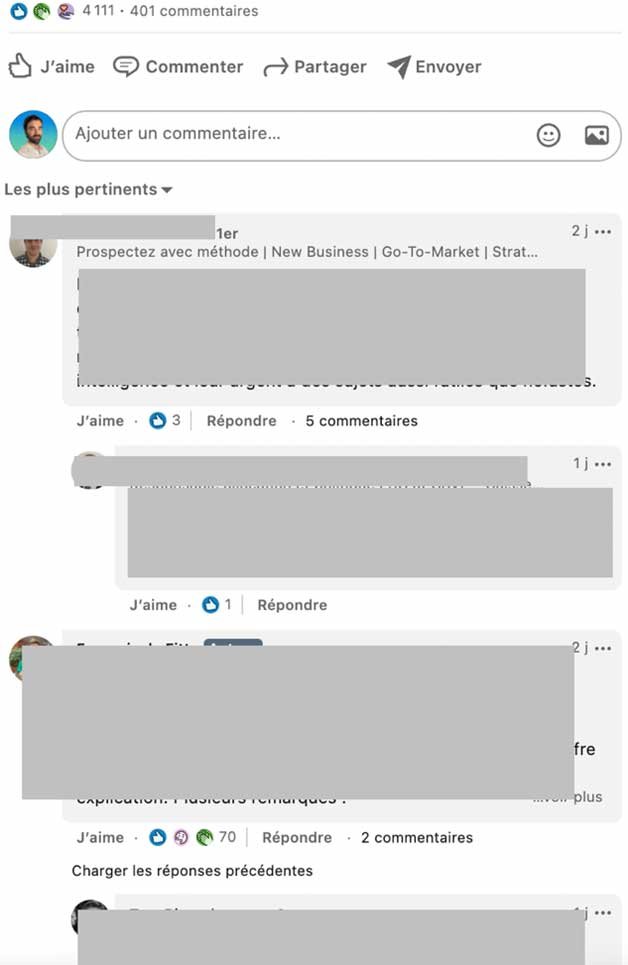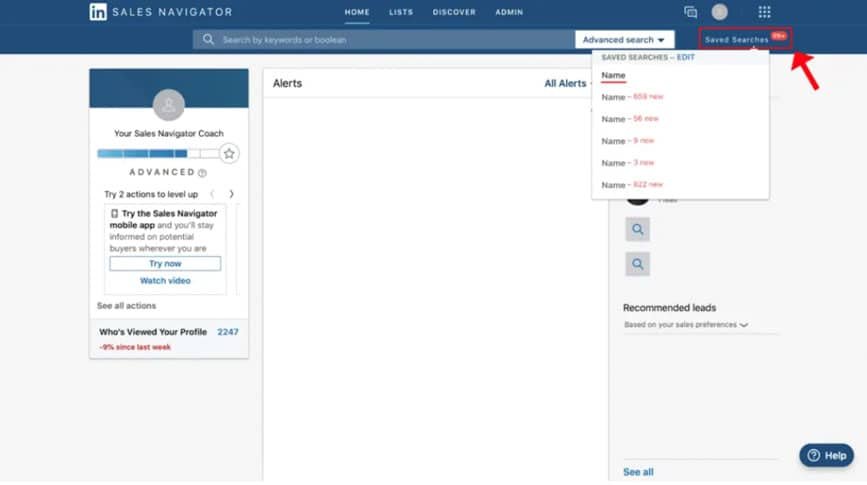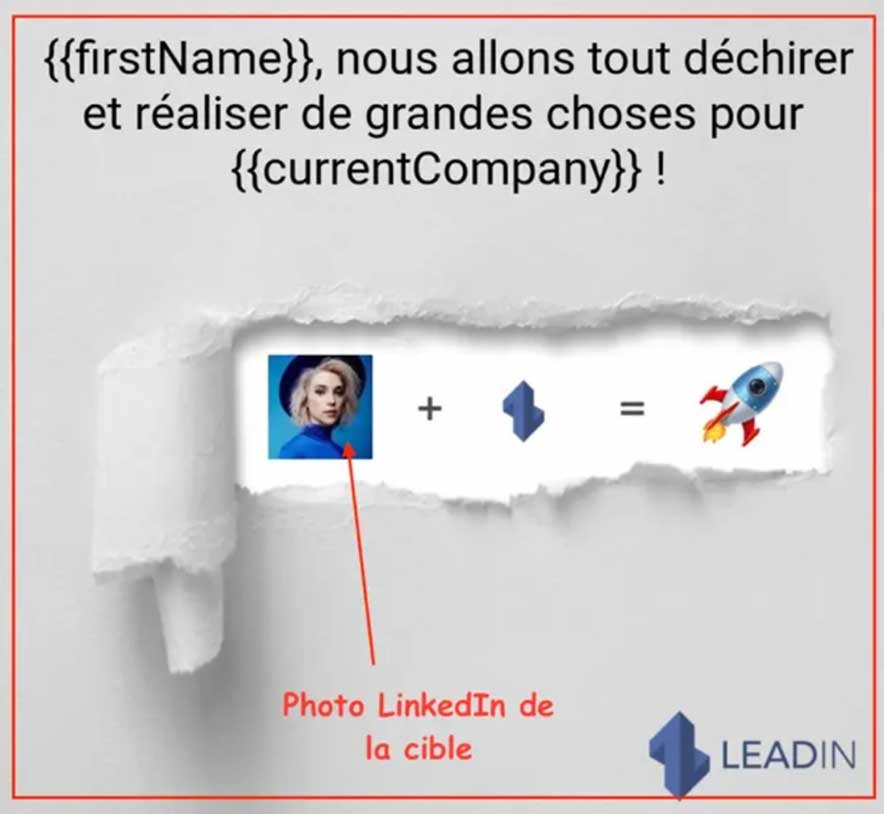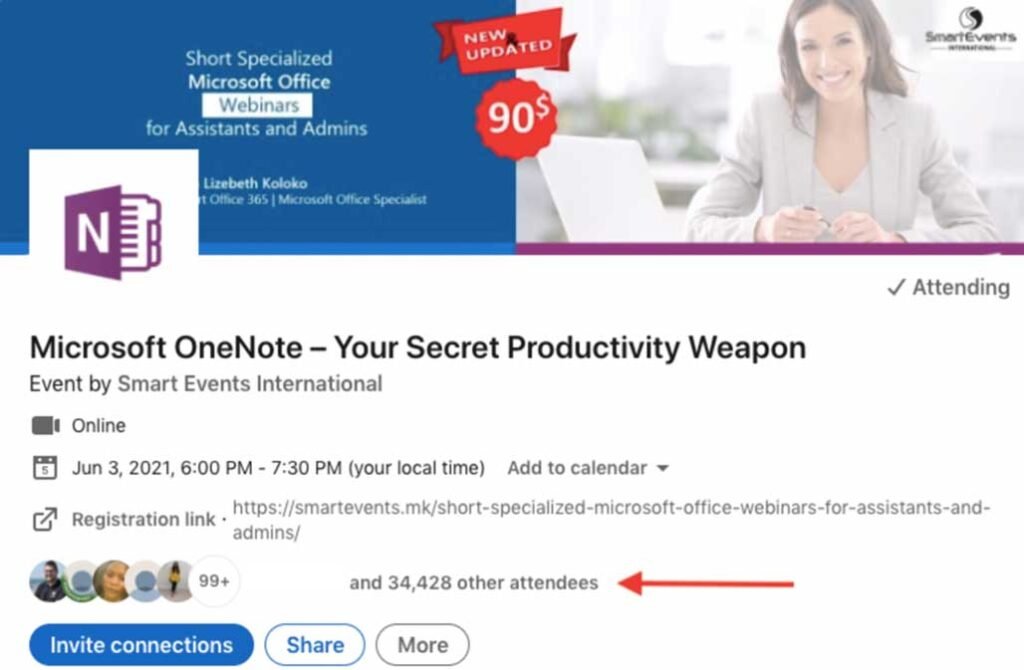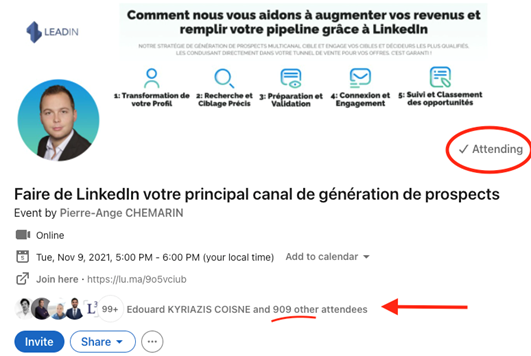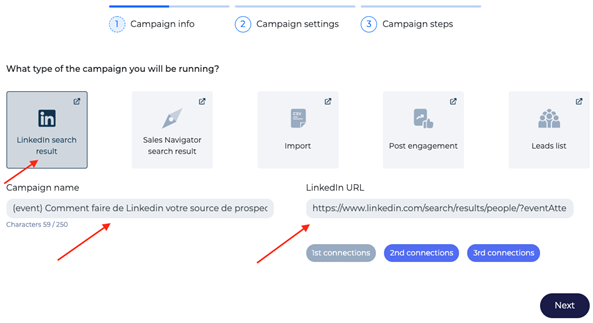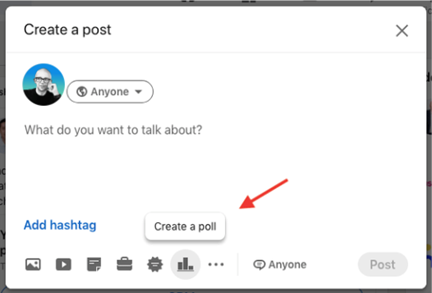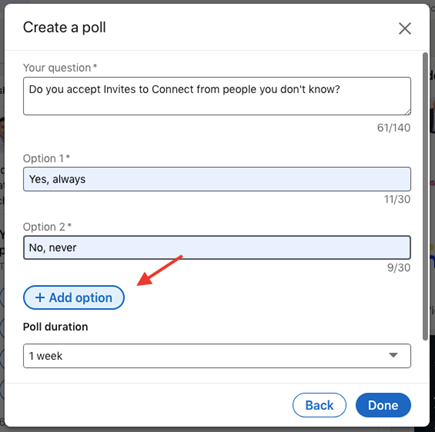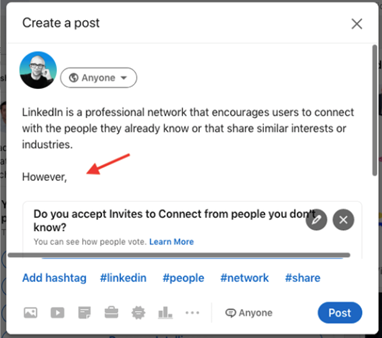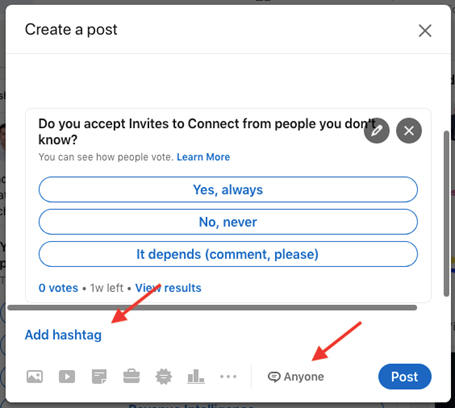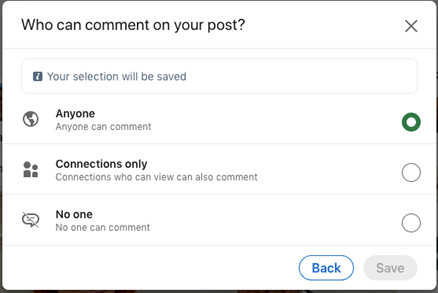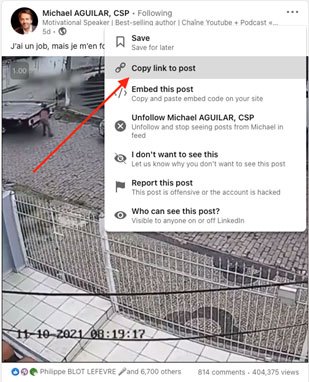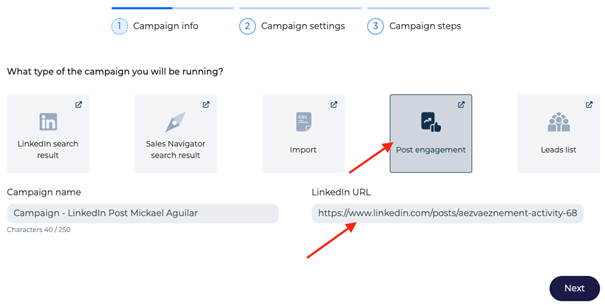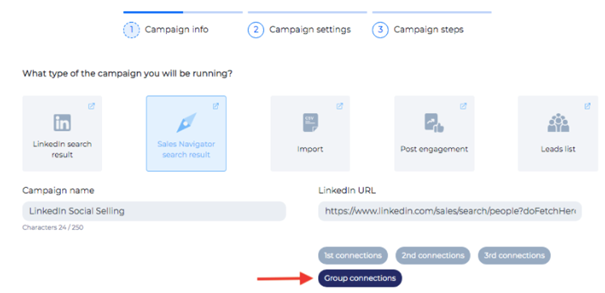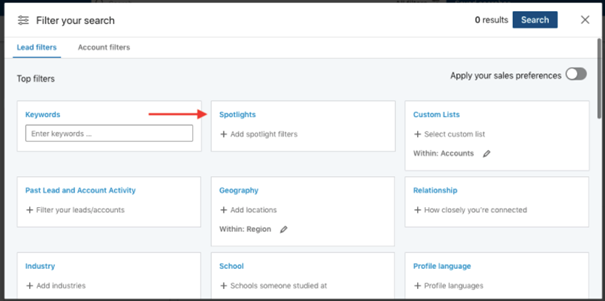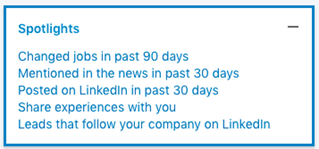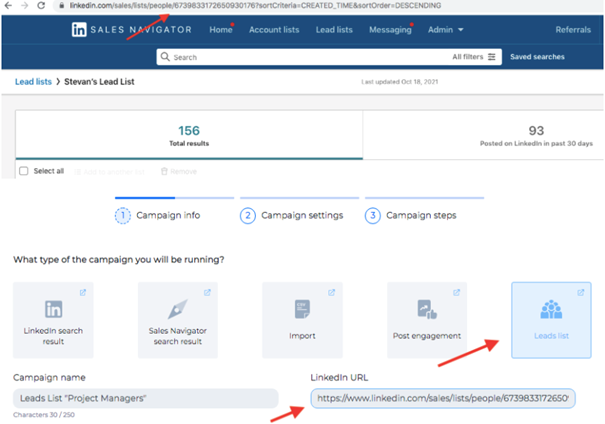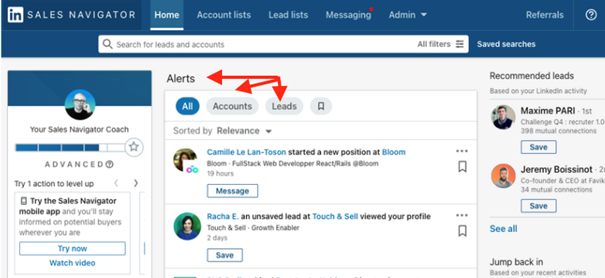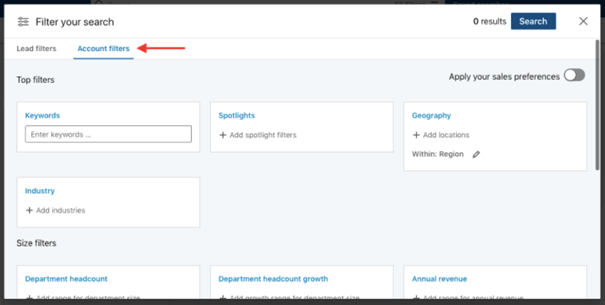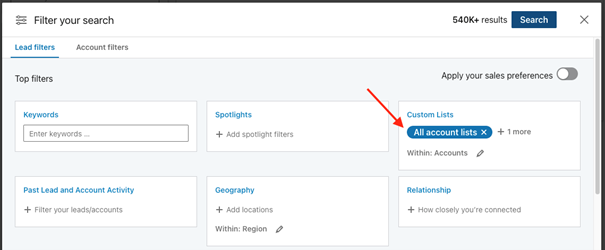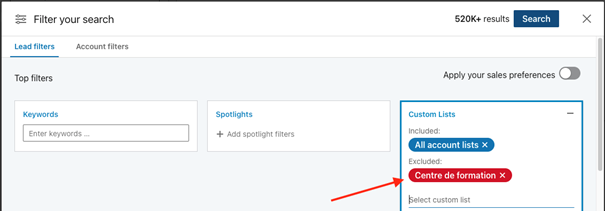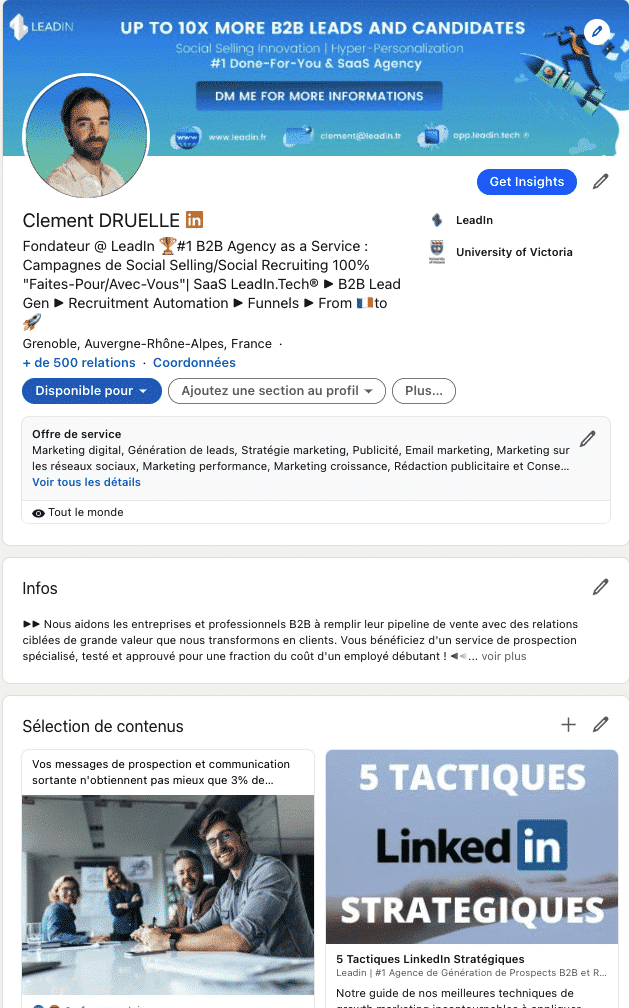There are many proven ways to find the best prospects on LinkedIn.
You can upload your email list, join LinkedIn professional groups to find relevant people, use paid tools like LinkedIn Sales Navigator , and more.
We’ve covered many of these tactics and more on our blog .
But today it seems like everyone is leading the same prospecting campaigns on LinkedIn !
If a sales rep has logged in with you to tell you that they came across your profile in the same LinkedIn group as you and started to sell your product … You know what I’m talking about.
Do not mistake yourself. Taking advantage of LinkedIn groups to find relevant prospects is a excellent lead generation tactic .
But today, people can recognize a sales pitch for miles.
So if you’re looking for new ways to find your best prospects on LinkedIn, you’ve come to the right place.
We’ll cover little-known tactics that are grossly underused. Chances are your competition won’t use them either and you can use these tactics to find highly qualified prospects .
Here is some tactics little known for finding people on LinkedIn:
- The “people also viewed” or “people also viewed” section
- Investigate competitor networks
- The recommendations and comments section
- See who commented on a post and engage with that audience
- Browse user interactions
- Search Alerts on Sales Navigator
- Hashtags assigned to companies
- Engage with the audience of an event on LinkedIn
Ready ? Let’s go.
1. The “other pages consulted” or “people also viewed” section
Do you know the private mode of LinkedIn?
By starting with this quick hack, you will be able to find relevant prospects and leads just by clicking on most profiles.
Yet most people miss it.
How is it going ?
Go to any LinkedIn profile, and on the right side, look at the “ other pages viewed “.
Click on “ Show more “to get an even bigger list of potential prospects!
This is a “ hack “LinkedIn is incredibly easy, but it’s a great way to start if you don’t know your prospects well.
You can use this tactic to find leads , prospects, business owners, freelancers based on similar profiles, and more.
So even if you are looking for a SaaS solution especially for growth hacking, you just need to click on a person’s profile. Then LinkedIn will do the work for you and provide you with a list of relevant prospects on the right side of their profile.
Preferably, the person whose profile you are viewing should already be close to your ideal prospect , so your results will be exactly the people you are looking for!
Note : some people have secured the privacy option “ People also consulted “in their settings. So even if not everyone has this section available on their profile, you can still check it out, as it only takes a minute!
2. Investigate your competitor’s network to find prospects
Do you pay special attention to your competition?
There are a lot of opportunities and growth hacks that you can capitalize on if you know who your competition is.
For example, you can spy on their advertising strategy to find out what they’re not focusing on and build that into your own strategy. Fill in what they lack and you will meet the needs of your customers!
Most importantly, studying your competition will open you up to new possibilities when it comes to finding potential prospects.
Here’s how you can browse your competitor’s networks and find quality prospects to connect with.
Put your profile in private mode
If you’re about to start exploring your competitor’s networks, try to avoid leaving your mark.
You don’t want to appear in their “ Who viewed your profile “and let them know that you were spying on them!
To do this, you can change the viewing options of your profile. Click on your profile picture in the upper right corner and go to “ Settings and privacy “. On the left you will see a tab called” Visibility Click on it, then click on “ Profile view options “.
You will see a screen that looks like this:
Choose how you want to be displayed – either as “ Anonymous LinkedIn member “, or like” Someone of “. The “ in “will generally be your university.
You are now ready to browse your competitor’s networks!
Visit their page
Before examining the individual members of their network, you may want to study the content of your competitors’ news feed.
Are there some great content ideas you can take inspiration from?
What are they working on? Do they have interesting topics?
Do they organize or participate in industry events that you should be aware of?
Are they having good results? Are there a lot of interactions on their posts?
Ask yourself these questions and try to get a good idea of the type of LinkedIn strategy approach they are using.
Maybe they’re doing something in a new way you never thought of!
Browse their connections
It’s pretty easy to see a person’s logins – it’s just a click away!
Under their profile picture, you’ll see the number of connections they have. Click on that number and you’re there.
But the best part about this approach is that when you access their connections, you have the same filters and options as in LinkedIn’s advanced search. You can click on “ All filters “and find the exact prospects that interest you!
This can be very useful if the competitor whose you look for connections has a large network of several thousand people.
Filtering these search results will make you save a lot of time .
You can customize your search for just about everything from training to current employer to areas of interest. You can even enter your own keywords to find very specific people if you want, just like with the advanced search on LinkedIn .
But getting those results is only the first step – it’s time to start prospecting with LeadIn!
In your connection message, be sure to mention the fact that you belong to the same industry as your competitor, because the prospect already knows it.
Prevent your competition from doing the same
We can be two to play this game: if you can go through the connections of your competitors and “spy” on their prospects, they can do the same with you!
However, if you want to keep your leads and forbid your competitors to go through your connections to target them with offers, you can do that easily.
Go to visibility settings again and find the option “ Who can see your connections “at the bottom. Select” You only ” and voila.
This will prevent your competition from doing the same thing we are doing right now.
3. Use the recommendations and comments section to find prospects
Skill recommendations are one place where you wouldn’t expect to find a lot of helpful leads, but you’re wrong: there are the value to take in this section!
Here is the problem : only active LinkedIn members recommend skills.
What does that mean ? When you consult the approved skills by your competitors (or by your connections), you will find active members . You will find people who are on LinkedIn every day, participating in conversations, and who might be willing to listen to your offer.
And, if you do it right and go through those connections that are relevant to your industry, you find high quality leads !
Just go to the page of the person whose reviews you want to review, scroll down to the reviews and you’ll see this:
As you can see, we have chosen a popular LinkedIn profile in our line of business, with a lot of connections and approvals. But the most interesting is that by clicking on one of these numbers “ 99+ “, you open a new window with all the people who have approved these skills.
This can represent several hundred people or, in our case, 928!
4. See who has commented on a post and engage with that audience
Another way to find the most active people on LinkedIn is to see who is commenting on posts in your industry.
Examining Your Competitor’s Pages can also be useful. But a more effective strategy might be to find a influencer of your sector having a certain audience and to consult its publications.
Chances are they have c lots of comments of people actively interested in the subject!
Go to “ See all activity “and select” Messages “at the top of the screen to see what your chosen influencer / prospect has posted. Click” comments “under one of his posts and you’ll see lots of potential prospects!
Any of these users can be a good connection since they are active in the community and follow a influencer of your niche .
And the best part of it all? You can reach all these people in a few minutes thanks to LeadIn!
Here is how it should be done:
- Find a post with a lot of engagement , click on the three little dots in the upper right corner, and select “copy link to post”.
- Log in to LeadIn , create a new campaign, select “Post engagement” and paste the link you just copied.
- Write your messages and be sure to mention that you follow the same influencer and like their ideas.
It’s as simple as that !
5. Explore user interactions
If you publish content regularly (which we always recommend), chances are a lot of people will engage with your posts.
If you don’t get interactions, you can work on your content strategy or you can use the LinkedIn advertising – but let’s not get lost.
So how do you get the most out of these interactions and turn into valuable leads ?
You can do this manually – just schedule a moment to browse your profile each day and see if there are any new engaged users.
But, if you have a lot of connections and too much engagement on your page, you can always use the option “ Post Engagement “on LeadIn that we mentioned in the example above!
6. Create a search alert in Sales Navigator
Want to know how to find people on LinkedIn without even taking a single action?
The creation of an alert search in Sales Navigator may be what you are looking for.
We already talked about LinkedIn Sales Navigator and how it can help you with your prospecting activities. You can use its advanced search to reach pretty much who you want and get great results.
One thing we love to do in Sales Navigator is create search alerts in order to get new leads while working on other things or even while sleeping!
It is very simple :
- Log in to your Sales Navigator
- Use the advanced search to find leads and give it a try!
- Click on the button “ Save search “at the top right of your screen.
- Give your search a name and, under “ Alert “, choose how often you want to receive alerts when there are new results for this search.
This way, you will have a constant supply of new leads that perfectly match your criteria.
7. Track hashtags assigned to businesses
Do you follow companies on LinkedIn for their content?
Whether or not you are interested in the activity of a company, you can still benefit from the fact of follow his activity .
How? ‘Or’ What ? By accessing people who are interested in what this company has to say.
And it’s not just about their followers – you can identify people who are interested in the same type of content but who don’t actually follow the company.
To do this, you can to follow hashtags . Browse the company page and see if they have any dedicated hashtags that they still use. Note that all companies can provide information up to 3 hashtags in their company page to help their referencing on the platform!
Click on those hashtags you see on company posts and follow them, you will have instant access to content directly from your industry and to people who are interested in those topics.
Connect with your audience via LeadIn
Knowing how to find valuable leads on LinkedIn is just the start – to get the most out of those leads, you need to start connecting effectively.
And to generate – actually – responses, you don’t want to use the same message templates that people see and send every day.
At LeadIn, we strongly believe in hyperpersonalization : the use of dynamic content like images and GIFs that use personalization techniques to create an amazing message.
Here is an example:
This approach allows you to completely personalize the content of your message using not only the name of your prospects, but also their job title, company name and even their profile photos!
And these are the kinds of responses we received:
The best thing about the hyperpersonalization included in the platform is that it is possible to do all this with ZERO knowledge in coding nor in complex workflow between multiple tools!
8. Engage with the audience of an event on LinkedIn
The events are increasingly popular on the platform, and when it comes to lead generation , there’s no better way to get a high acceptance rate than to reach out to your prospects with a very concrete referral.
For example, if you are targeting prospects participating in a specific LinkedIn event, the chances that your invitations to login will be well received are inherently high!
And do you know what that entails? Higher conversion rates.
All of this can be summed up in the 5 steps below :
- Find the event you want for target prospects .
- Sign up at the event to see who is attending.
- Copy and paste the URL in the LeadIn Campaign Builder.
- Personalize your invitation to login by referencing the specific LinkedIn event.
- (Optional) Be creative in your engagement actions with hyper-personalization of images and GIFs .
All of these steps will be the subject of an upcoming in-depth LinkedIn guide/tutorial/growth hack where we’ve engaged active participants of a popular productivity event, so stay tuned.
Teasing below! 😉
9. Engage attendees of a specific LinkedIn event
The first hack for finding leads is to target people who have attended a specific LinkedIn event .
As a professional in a certain industry, you’re more likely to attend LinkedIn events that enhance your knowledge and skills or simply benefit the industry you’re in.
You will have to think the other way! Take the time to attend a LinkedIn event dedicated to your target audience .
Not only is it the perfect place to find leads , but it also gives you valuable insight into their needs , doubts , and opinions .
The knowledge you gain by attending a LinkedIn event like this can help you move your business in the right direction.
This can be a great way to personalize your approach and give the prospects you find the impression that you know your business subject . Because you certainly did.
How do I find prospects who attended a specific LinkedIn business event?
Open your LinkedIn profile . Find the event whose attendees you want to target.
There are two ways to search for LinkedIn Events:
1. Type the specific name into the LinkedIn search engine (in case you’ve attended one before, and know where to find your leads)
2. Perform an empty search. This takes you to the “Events” button option
You will get a complete list of all future LinkedIn events. Research an event that you think could help you find qualified prospects. Use keywords to narrow your search.
Step 1: Attend the event
You won’t be able to see people on LinkedIn who attended a specific event if you don’t also register for that event.
Know that you can engage participants before and after . However, as we mentioned above, it is better for your prospect to attend for real and then engage them.
Step 2: Filter the participants
If there are too many participants, or if you just want to add an extra criterion, go ahead and reduce their number using LinkedIn filters .
Step 3: Copy and paste the URL to LeadIn
Unless you want to manually contact each lead you find, copy-paste the URL into LeadIn ‘s campaign builder.
Click on ” Next ” and create your target prospecting campaign according to the needs of your business.
Message template
This template is dedicated to sending personalized connection requests to connect on LinkedIn. However, you can refer to a certain LinkedIn gathering that you and your potential customers have participated in in any type of prospecting campaign ( LinkedIn, email, or multichannel ).
Hello {{FirstName} },
I saw that you are also attending the “How to make LinkedIn your number one lead source in 2022” event…and I’m sure there’s nothing more important than continuing to generate leads to generate leads. growth, right? On your end, have you ever used these LinkedIn strategies for sales?
To read you! Yours truly.
So…can you guess how powerful this hyper-personalized engagement method is over the usual sales messages? 😉
PS: Consult the detailed guide on this LinkedIn growth hack
10. Find prospects with LinkedIn surveys
The second technique, LinkedIn polls are the hot new content taking over our news feeds. So it has become handy for finding prospects , as well as getting valuable insight into industry trends , needs and expectations . Additionally, LinkedIn encourages this type of content, and as a result, it gives LinkedIn surveys high organic reach and visibility .
If you design your LinkedIn questionnaires with the aim of generating leads afterwards, define well the questions that can arouse the interest of your target audience.
How to use LinkedIn surveys to find prospects
Step 1: Create a survey on LinkedIn
1. Go to your LinkedIn homepage
2. Click on ” Start a post “
3. Click on the chart icon
4. Enter the question
Submit a minimum of two and a maximum of four responses. Set the delay. It can last a day, three days, a week, or a maximum of three weeks.
5. Once you are done setting up the LinkedIn poll, the “ Done ” button allows you to create an accompanying LinkedIn message
6. Option : Introduce your survey or give additional explanation if necessary
7. In the bottom right corner, you have the option to allow comments or customize who can post messages on your survey
8. Click on “ Anyone ”, then choose one of the following options
Wait until the survey is complete to start finding leads in the next step and see a first result.
Step 2: Import the participants
As mentioned above, this type of content proves to be a real goldmine for your business to find leads.
Once the survey is complete, you can extract and engage all participants with personalized messages to generate qualified leads:
1. Click on the three dots “ … ” at the top right of the survey
2. Click on ” Copy link to publication “
Step 3: Create an automated messaging campaign
Unless you want to reach out to each of your targets manually, which we think is a task with little added value, use the copied link with the potential leads you found to create a campaign in LeadIn .
3. Go to your LeadIn account
4. Create a new campaign and choose the “ Post Engagement ” start option.
5. Paste the copied link in the LinkedIn URL field
6. Click on ” Next ” and start the creation of your intelligent sequence to generate a maximum of engagement in autopilot .
Message template
The use of the LinkedIn poll reference in the invitation to connect (or any other type of message) is exclusively reserved for the creator of the LinkedIn poll .
Only the creator can find the leads that attended the conference and retrieve their profile URL. That’s why your model might look like this:
Hello {{FirstName} },
Thank you for participating in my latest LinkedIn survey. Interestingly, you never personalize your login invitations. Does it affect your acceptance rate? I’m curious to know more.
Looking forward to hearing from you, I am sending you a connection request!
11. Find leads through your own or other people’s content
When we talk about LinkedIn content, we’re talking about LinkedIn articles, posts, and surveys (see above).
Finding leads through articles and publications ( posts ) on LinkedIn, whether it’s your own or someone else’s, might just be the best thing to do on this platform.
Even though the character limit for posts has been increased from 1300 to 3000, the most beneficial advice we can give you is that quality matters.
Right from the start . When writing a post on LinkedIn, remember that you only have 210 characters to get someone to click ” See more ” (post continued)!
How do you find potential customers who have engaged with a certain LinkedIn message?
Step 1: Find the message with the right prospects
Just like with LinkedIn surveys , it’s all about finding or creating LinkedIn messages that primarily pique the interest of prospects. To do this, you need to take the perspective of your target audiences .
Here are three ways to find targets with LinkedIn content and turn them into leads:
Check if any of your connections have posted posts that could benefit your lead generation
· Learn about “ LinkedIn influencers ” that could lead you to a qualified target audience. Consult their publications to find prospects
· Create a LinkedIn post yourself.
Step 2: Choose a “Post Engagement” campaign in LeadIn
In all of the above cases, the data collection process is the same:
1. In the upper right corner of the message, click on ” Copy link to post “
2. Paste it in the LeadIn campaign creator
This is again the type of campaign called “ Post Engagement ”. It will be automatically selected after you paste the link.
From there, create a campaign and messages that align with your business goals to maximize your bottom line (same process as above with a LinkedIn survey link!).
Message template
If you are using automated delivery, remember that LeadIn can collect up to 2500 people who reacted to a certain LinkedIn post. This can be your content or that of another member .
Referring to the post or part of the post that resonated with you the most can be a great way to reach your prospect ‘s inbox. It can be something as simple as:
Hello {{FirstName} },
I saw that you are also a fan of Mickael Aguilar. Did you attend his lectures? Looking forward to discussing. For my part, I just wanted to open my network to professionals interested in sales in general.
OR another example…
Hello {{FirstName} },
I saw that you also liked {{Author name}}’s post on personalized advertising. There is indeed a fine line between using customer data for relevant advertising and misusing it, don’t you think?
Anyway, I would love to get in touch with you.
Once again… do you see the relevance of such an engagement strategy versus the “traditional” sales messages sent on the platform? 😎
PS: Check out the in-depth growth hack guide on generating leads with LinkedIn feed posts .
12. Target LinkedIn Group Members
LinkedIn groups are the perfect place to find leads. They indicate in the most direct way the area of interest of your potential prospects, which you can use as a common denominator during your approach.
Very often, the rumor has it that LinkedIn groups are not very active … However, many professionals in the sector consider them to be a very qualified source for finding prospects.
Although the “Groups” filter is only available to Sales Navigator users, using LinkedIn groups is a very effective prospecting strategy that generates great long-term results!
How to use LinkedIn groups to find prospects
1. Open Sales Navigator’s “All Filters” option. Choose “ Lead Filters ”.
2. Scroll down the screen. Click on ” Groups “.
3. Type the name of the occupational group . Sales Navigator automatically suggests other groups with the same or similar topic .
In the upper right corner, you immediately get an overview of how many targets you have found.
4. Use one of the other filters available in Sales Navigator until you find the targets you consider most qualified.
5. Copy-paste the URL of your final lead search into LeadIn .
6. Create a campaign based on your business needs using the sample template below.
Message template
Whether you decide to reach all members of a LinkedIn professional group or filter them more deeply, referencing a LinkedIn group you all belong to is a great way to boost your acceptance rates:
Hello {{FirstName} },
I am also a member of the LinkedIn Social Selling group on LinkedIn. I often publish articles on sales and prospecting, so I saw the interest in connecting us.
I hope you see it the same way!
Have a great day.
13. Sales Navigator “Underused” Filters for Finding Prospects
Sales Navigator’s filters give you plenty of options to find exactly the person you’re looking for within a company. With 24 ” prospect filters ” at your disposal, the quality of your targeting skyrockets.
Are you ready to discover 7 Sales Navigator tips that lead generation experts use to find the leads most likely to convert to leads?
Let’s go.
Tip #1 – Prospect “Spotlights” filter
Not only are these professional members more active on LinkedIn, but the 5 “Spotlight” filters are excellent for personalizing your invitations to connect.
For example, you can use this target section to:
- Praise a prospect for changing jobs in the last 90 days
- Get mentioned in the news
- Referencing a target post he made on LinkedIn
- Highlight an experience you share
- In the event that they follow your business on LinkedIn, but are not your customers, they may be in the research phase of their buyer journey ( followers to your business page) and are interested in what you have to offer. Reaching out to them first could help you.
Tip #2 – Boolean Search
Boolean search is a feature available for both LinkedIn Premium and Sales Navigator .
It involves combining keywords with modifiers such as ” AND “, ” NOT ” and ” OR ” to produce more relevant results. The three operators (AND, NOT, OR) must be written in upper case. You can use it to filter by keywords, companies and titles. It is mostly used to filter by keyword.
· AND – shows tracks that meet both criteria. For example, if you put Manager AND Sales, you’ll find leads that meet both criteria on their LinkedIn profile.
- OR – it shows tracks that meet one of the criteria. For example, if you put CEO OR CFO, you will find potential clients who occupy one or the other position.
- NOT – place it in front of the target keyword to exclude that criteria from the search in your result, such as a specific company for example.
Combine them for an advanced search. As in the equations, the use of parentheses allows to define the priority of the associations of Boolean connectors:
(Editor or “Content Editor”) AND “Content Manager” AND Editor
The results will show one of the criteria in parentheses (or both) and the other two.
If you have more than one word, be sure to use quotation marks.
Tip #3 – Exclude prospects
When looking for prospects on LinkedIn, remember that you can exclude some of them from the search results.
Not all filters support this target option, but the majority do.
Tip #4 – Build a Target Prospect List
Once you’ve narrowed down your search using the necessary filters, perform the search and select prospects.
As you can see, the prospect list option guarantees the best quality . Not only are they selected through Sales Navigator’s advanced filtering , they are also added manually .
Once you’ve found leads that might be interested in your solution, click the ” Save ” option in the top right corner of each profile.
You can also select as a group the leads you want to add by checking the box to the left, next to the lead’s profile picture, then click “ Add to List ” at the top of your search.
You can add your prospect to an existing list or ” Create a prospect list “.
Use a prospect list in your automated prospecting campaign with LeadIn
1. Click on the “ Leads List ” option in Sales Navigator to view your lists.
2. Choose the list of prospects. Copy-paste the URL into LeadIn .
The ideal targeting option for leveraging your LinkedIn lists and creating automated prospecting campaigns based on your business needs.
Tip #5 – Use Alerts
In the upper left corner, click on “ Sales Navigator ” or on the “ Home ” option.
You get an overview of all the updates regarding the leads that you have saved in your list .
This is information you can use to customize your manual approach. You will always get real-time updates on the leads you have found that are of value to your business.
Tip #6 – Show Similar Profiles
Find the leads that best match your Ideal Customer Persona criteria.
Once you find them, choose one and click on the “ … ” in the upper right corner.
Choose ” See similar “. Sales Navigator will find up to 100 LinkedIn members as similar to your KPI as possible.
After Sales Navigator does the research for you, save your result to a prospect list by following the instructions mentioned above.
This way you will be able to use the targets you found in LeadIn .
Tip #7 – Custom Lists
Here’s a tip that not many people know about.
First, use account filters to find businesses that are your qualified leads:
Manually choose the companies you want to include in your list of accounts . The process is the same as for the prospect list .
Then, use this list of accounts in the ” Custom Lists ” prospect filter.
The list will take into account all the people who work in these companies. You can narrow them down further by using, for example, the ” Title ” filter and targeting only business decision makers.
Also, this filter supports the ” exclude ” option.
For example, you can use this criteria to exclude prospects who are already on a list or who have already been contacted .
Tip: You can use it as a blacklist saved on Sales Navigator!
14. The Profile Redesign – How To Turn Your Profile Into A High Converting Landing Page
Most people treat their LinkedIn profile like a CV.
If this is your case too… you are doing it wrong!
Your profile is a key digital element that can generate a consistent flow of prospects for you organically, if you do it right.
Think of it more like a sales demo or a landing page/”digital flyer” rather than a resume.
Here are the 3 key areas to optimize:
- Profile picture
- Title
- summary
There are plenty of other things you can optimize too, but start with these 3 and you’ll be 80-90% ahead of the competition.
1. Profile picture
Just in case… grainy photos, partying, or even worse nothing at all… are NOT acceptable!
Your profile picture is the first impression people have of you. If you want to make a good impression, it’s simple:
Get a crisp, professional photo and smile.
Here is mine:
Your profile picture plays a major role in getting your prospects to click on the “Accept” button of your connection request.
2. Profile title
Does this sound like you?
« Best Company CEO/Founder | 27x winner | Innovator | Influencer »
You may want to consider making changes.
Other examples of bad titles are:
- President of…
- VP / Vice President of …
- Director of…
- Boss of …
The truth is, no one cares about you or your business. Your title should be customer-centric.
It must answer the question “what does it bring me?” »
What your prospect cares about is how you can help them, that’s all.
There are many other areas in your profile where you can put your current job title.
…but if your goal is to generate leads organically from your profile, display your headline for your prospect.
Here are some simple frames to turn your headline into a powerful uplifting pitch:
For founders / owners / CEOs:
- “I help / help / teach [marché / industrie cible] at [la valeur / la solution que vous fournissez] by / using / by [comment vous le faites] “
For sales representatives / Biz Dev or those representing a company:
- ” We help[marché / industrie cible] at[valeur / solution que vous fournissez] by / using / by[comment vous le faites] “
If there is enough space at the end, you can add your title and your company.
Here is my example:
- « Helping Start-Ups, Saas, ESN & Agencies Get Sales Meetings With Their Ideal Clients | Founder @ LeadIn »
You know the target I serve (B2B), the problem I solve (generation of leads and customers) and how I solve it (LinkedIn + sales funnels…cold emailing).
Your connection acceptance rate will be based solely on whether your prospect looks at your profile and thinks “this person can help me”.
3. Profile summary
Most people treat their resume like a resume or talk about themselves in the third person (terrible!).
Your profile summary should read like a “soft-pitch” for you and what you do, while staying focused on your KPI and ideal prospects.
It should cover the following points:
- Who you serve
- What problems do you solve
- How do you solve them
- Your legitimacy
- Next Steps / Call to Action
Resist the urge to list your accomplishments and experience here. All that will happen is scare away your visitors.
Here is my profile summary:
By reading this you know exactly what I do, who I serve, how I serve them, and how to get in touch with me.
My profile receives around 200 organic views per week. This means that 200 of my ideal clients see my profile summary every week!
For context – LinkedIn ads average about $8 cost per click, which means I’m potentially saving $6,000-$7,000 per month in ad spend.
If you need inspiration for your profile summary, the LinkedIn blog has some great examples here:
Remember – don’t be selfish. Your profile must be CUSTOMER CENTERED! For those who want more details, find my article “ How to optimize your linkedin profile? “
15. The “Perfect Prospect” list – How to create a list of thousands of ultra-targeted leads for less than 100 €
Here’s where the fun begins.
You’ll start to see how powerful LinkedIn is for finding virtually any decision maker at any company you want to contact.
Quick warning though – if you’re not technical this tactic can frustrate you. Just follow the step by step instructions and you will be fine.
Once your profile is optimized for your PKI, it’s time to build a list of your perfect prospects.
For this tactic, you will need 2 tools that cost less than $ 100 / month.
The 2 tools are:
- Sales Navigator (75 € / month)
- Phantombuster (free or paid plan depending on daily volume)
Here are the steps to building a list of thousands of targeted “perfect prospects” each month.
Step 1: Build a List of Targeted Prospects Using LinkedIn Sales Navigator
- Go to Sales Navigator
- Click on “Advanced” at the top right, then on “Find prospects”
- Use your ICP and Sales Navigator filters to create a list of 500 to 1,000 targeted prospects. Sales Navigator only loads pages for 1,000 results on each search, so keep filtering until you get there
- If you trust LinkedIn’s ability to find your exact leads (note: it’s not 100% accurate), you can copy the lead search URL from Sales Navigator and skip to the next step.
- If you don’t trust LinkedIn to generate the perfect lead list, you can manually browse and tag the right leads and / or “save as a lead”. From there, you copy the Sales Navigator lead search URL and go to the next step
NOTE: Click “Save Search” at the top right of Sales Navigator for future reference.
Here’s an example targeting B2B SaaS founders in CA, WA, NV, OR (USA), employee size 11-50, and 2nd degree connections.
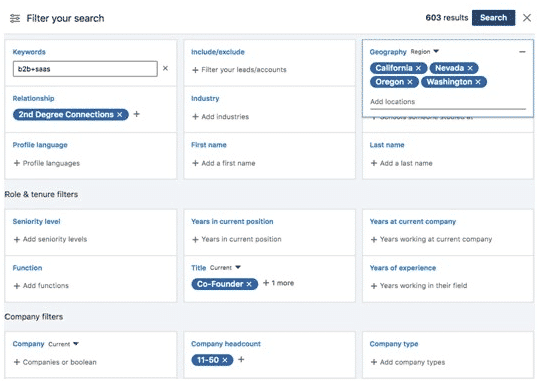
Step 2: Upload Search Results from Sales Navigator to CSV
- Copy the URL of your saved Sales Navigator lead list
- Go to Phantombuster.com and create an account
- Access the API and search for “LinkedIn Sales Navigator Search Export”
- Follow the instructions on the page to export your lead search to a CSV
- Once done, import the CSV into Google Sheets
Step 3: Generate official LinkedIn URL (instead of Sales Navigator URL)
- Return to Phantombuster.com
- Go to API and select “Sales Navigator URL Converter”
- Follow the instructions and drop your Google excel sheet ID from the previous step in the API
- Click the three dots next to “Launch”
- Once done, you will get a separate CSV which will include the official LinkedIn profile URL of your prospect list
Step 4: Consolidate the data into a single worksheet
- Take the Phantombuster LinkedIn profile URLs and replace the Sales Navigator profile links from your original Google excel sheet
The main final columns you will need for the next step are:
– First name
– Last name
– Company Name
– LinkedIn URL
If you did the steps right (and your head didn’t explode!), you should now have an ultra-targeted list of your ideal prospects who match your exact KPI – and a process you can repeat for less than 100 € / month.
Keep this list handy, we’ll use it for the next tactic where you can connect with 50-75 of these ideal prospects every day, completely outsourced.
16. Login Sequence – How to Connect Every Day with 50-75 of Your Ideal Customers On Demand
Now that you have your list of perfect prospects, we’re going to use them to connect you with 50-75 of them every day without you spending hours on it.
There are many tool options for LinkedIn Sequencing, but here are 2:
- Dux Soup, LinkedHelper, Prospectin (15 € / month, but LinkedIn is cracking down hard against chrome extensions by banning users from the network for life)
- Orca (69 € / month, but safer than Dux Soup because it is not an extension)
Just make sure it has the ability to download a list of LinkedIn URLs to login and view profiles.
Before we begin, there is a disclaimer I need to issue.
LinkedIn disclaimer
Be careful when over-using LinkedIn! If you have too much activity (profile visits, connection requests, connection refusals, pending connections, messages, etc.), your account may be suspended or permanently banned in certain cases.
Conclusion: don’t be greedy, don’t push it to the limit and don’t be a spammer!
My rule of thumb is not to exceed 75 connection requests in a 24 hour period, not to exceed 1000 pending connection requests at any time (you can withdraw them), and not to visit more than 200 profiles in one day.
I am NOT a LinkedIn moderator or administrator, these are just my conservative estimates. I am NOT responsible if you lose your account while trying anything mentioned in this guide.
If you are not comfortable with automation , perform this tactic manually.
You have been warned. Pay attention!
Cool?
Alright… let’s move on.
For this guide, we’ll be using Orca in the examples.
Step 1: Create a Campaign Using Your List of Perfect Prospects
- Go to Orca and “Create Campaign” (tag it according to your KPI, for example: “B2B SaaS Founders | 11-50 | WA, OR, CA, NV”)
- Click on “Download a CSV of LinkedIn profiles”
- Find your perfect prospect list and upload it
Step 2: Configure your campaign sequence
- We like to do a profile visit as the first step, a login message as the second step, and a follow up message when they accept the third step
- Your login message should be specific to your PKI and / or their job title, and the follow-up message is to thank them, NOT introduce them
- Ex. connection: “Hello[nom] , I am trying to connect with[titre du poste] in industry[de leur marché] . Would you like the opportunity to connect with us and share ideas if you are open to it
- Ex. follow-up: “Thank you for accepting my connection request[nom] . Looking forward to hearing more about you and your[entreprise] »
Step 3: activate the campaign
- Once you have configured your sequence, select the days you want to run it and activate it
Boom! Now you have a way to connect with dozens of your perfect prospects every day without doing it yourself.
But… what do you do once they are part of your network?
Let’s talk about that in the next tactic…
17. The Content Machine – How to Create Content That Generates Demand, Leadership, and Inbound Lead Flow
One of the most important Linkedin tactics because having a large network of connections is useless unless you have a way to turn them into interested leads. One of the best ways to do this is through content marketing and (inbound) conversation. By creating a “content machine,” you will have a way to generate demand, thought leadership, and inbound leads. You will gain credibility and confidence, gain new connections and beat your competition by keeping your number 1 spot with your audience.
There are countless types of content you can post, but keeping it simple with a mix of these 3 has been effective:
- Content relevant to your PKI
- Abbreviated Status Updates
- Detailed status updates
Let’s take a look at each of them now..
Content relevant to your PKI
Organized content can be in the form of images, videos, articles, etc. created by other companies that target your audience but are not direct competitors.
You can use these 2 free tools to help automate this part:
- Feedly (automate the provisioning of new articles of interest)
- Hootsuite (automate article publishing)
Follow these steps to find curated content relevant to your audience.
- Make a list of 5-10 of the best influencers, blogs, websites, etc. that your audience follows
- Create a free Feedly account and find the sources in your list. This will give you a feed of all new content from these sources every day.
- Pick once a week on a day where you’ll spend 1-2 hours finding the best content from these feed sources and uploading it to Hootsuite for automatic posting.
- With each post, add a short blurb with your thoughts or a question to engage your audience.
Note: curated content won’t get the most engagement or views, but you will start to build your credibility, trust, and top-notch awareness with your audience by posting content that is useful to them.
2. Abbreviated status updates
Remember the first time Facebook business pages came out, where each post reached 50-75% of your entire audience? This is currently where LinkedIn is, and by posting 2-3 abbreviated status updates per week, you can generate a massive amount of organic views, even with a smaller network. The purpose of these posts is not to go viral, but to engage and stay in front of your audience at all times. That said, some posts will go viral if you post solid content.
I use these 3 formats for my abbreviated status updates:
at. Questions
Questions are a great way to engage your connections while getting them to do the heavy lifting for you. When someone likes or comments on your post, it becomes visible on their network even if you are offline. This can cause a ripple effect with thousands of extra eyeballs on your posts and many new connections gained without you reaching out.
b. Sharing opinions / advice
It can be your thoughts/opinions on a certain topic or quick tips. The key is to keep it relevant to your audience while still making it interesting enough to engage you. You can shuffle the questions at the end if you want a better chance of engaging your audience.
vs. Short native LinkedIn video
Native video is starting to take off on LinkedIn, and you can get an incredible amount of engagement if you do it right. Short videos of 1 to 2 minutes that are relevant and useful to your audience work best. Also add a text description to your post to increase engagement. The key here is to KNOW your audience. Don’t just randomly post selfies and talking heads videos.
Ex: My audience responds well to tactics, so I created videos and posts with actionable B2B sales and marketing tactics.
d. Detailed status updates
It’s essentially the same as abbreviated status updates, just longer and more extensive. Personal stories and experiences related to your target market are a great choice.
Posting schedule:
I recommend posting at least 2-3 times per week using a mix of curated content, short and long status updates. If you have around 3000 connections. With over 1,000 views on each post, that means each post is seen by around 35-50% + of your audience. If you’ve optimized your profile in Tactic # 2, around 8-10% of people who view your post will click on your profile. In my case, that means around 2-300 profile views each week.
Would it help you if 2 to 300 of your ideal clients check your profile every week, interested in finding out more about what you do?
18. The Appointment Generator – How to Turn Leads into Big Money Leads, Appointments, and Sales Opportunities
In this tactic, you will learn how to turn your relationships into leads and interested dates using direct messaging. Most people are afraid of this step, but if you’ve done Tactics 1-4 correctly, you’ll be ready to communicate successfully.
Let’s review what you’ve done so far:
- You turned your LinkedIn profile into a high converting landing page
- You’ve Built a Laser Targeted List of 500-1000, Your Perfect Ideal Leads
- You have activated your sequence which connects to 50-75 of your perfect prospects every day without you taking care of it manually
- You’ve created a calendar and content machine that builds your leadership, generates demand, and gets you a flood of inbound leads.
Now all you have to do is systematically reach out to your contacts, bring the conversation to an offline date.
None of this is required, but if you want a predictable lead pipeline and flow instead of sitting around waiting for people to contact you, this step is important.
Let’s go now …
Step 1: Export your leads to a Google Excel sheet
- Click on “My network”
- Click on the number above “Connections” on the left side
- Click on “Managed Synchronized and Imported Contacts” on the right side
- Click on “Export contacts”
- Check the box next to “Connections”
- You will receive a CSV download in 5-10 minutes with all the data of your connections

Step 2: Clean up your data
- Remove any irrelevant friends, family, or connections that aren’t your perfect prospects from your list
- Create a separate tab for campaign tracking with header columns for first name, last name, company, title, LinkedIn profile, and to track posts 1, 2, and 3
Step 3: Create your email sequence
We like to use a simple framework from the following 3.
- Message 1: Provide value – provide value in the form of content or a solution
- Message 2: Ask – ask if it makes sense to take the conversation offline
- Message 3: Follow up – follow up on your request to see if they are interested
Step 4: Segment Your List and Send Your Mail Sequence
- Segment your list according to the volume of messaging you want (not to exceed 50 / day)
Ex: if you have 100 connections, you can divide into 2 groups
- Start with message 1 and send to your connections segment
- Use the campaign follow-up sheet to mark prospects that you have message 1
- Copy each lead’s email URL to your tracking sheet for easy access while following up
Step 5: send follow-up messages
- Send messages 2 and 3 as follow-ups, spaced 1 to 2 weeks apart
- Plan all interested leads in an appointment
If you have your detailed PKI and appropriate messaging, you can expect an 8-10% positive response rate. This means that if you have 100 contacts, 8-10 of them will be interested in meeting with you or your sales team. What would 8 more appointments per month with qualified and ideal prospects mean to you?
Let’s do some quick math to find out…
THE KING FORMULA
Conversion rate * Customer lifetime value = Lead value
Before I close things off, I want you to do the ROI formula yourself so you can figure out how much these tactics could do for you.
Let’s take the example of the 8 appointments per month above, direct messaging only.
Our agency closing rate is around 30% and the client lifetime value is €25,000.
For our formula, that would mean ..
30% * € 25,000 = € 7,500 lead value
This means that EACH LEAD should be considered worth € 7,500.
With 8 prospects / appointments per month, this means that we generate € 60,000 in prospects each month.
Do the math using your own numbers and you’ll see how much of a game-changer this can be for your business.
5 key points to remember to generate 50 meetings and 13 closed offers in 2 months with these LinkedIn tactics
When it comes to generating high-value B2B leads, appointments, and sales opportunities – LinkedIn should be the #1 platform you seek.
These are exactly the 5 linkedin tactics that we used to generate 50 appointments and 13 closed offers in 2 months. We continue to use them …
Now that I’ve lifted the curtain and shown you how to do the same, it’s time for you to take action and try it out for yourself:
A recap and 5 key takeaways from the linkedin tactics we’ve covered:
- Optimize your LinkedIn profile by starting with your profile picture, title, and summary. It should serve as a customer-centric landing page, not a resume.
- Take advantage of Sales Navigator’s ability to filter your exact PKI. You can create lists of 1000 of your “perfect prospects” each month for less than $ 100.
- Sequence the process of connecting dozens of your perfect prospects every day with a tool like Dux Soup, LinkedHelper, Prospectin or Orca. Be careful with automation.
- Build your confidence, credibility, and leadership by posting helpful curated content, abbreviated status updates, and lengthy status updates. This will result in inbound prospects contacting you.
- Turn connections into valuable leads, appointments and sales opportunities using a “multi-point” messaging campaign. Use a simple Google Sheets to track your campaign.
Conclusion
There are many inventive ways to use LinkedIn to find prospects, and these techniques all share the same logic: be creative and find prospects who are interested in what you have to say.
Don’t hesitate to add these LinkedIn search techniques to your arsenal, and remember to always engage every prospect with personalized messages to get the most out of your prospecting efforts. Because there has been no better time to create real personalized relationships with the SOCIAL selling !
So, want to get ahead of your competition with advanced personalization?
Start your free 14 day trial of LeadIn and see for yourself how easy it is!
Read more :

